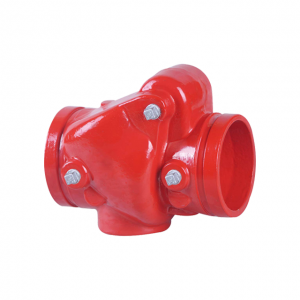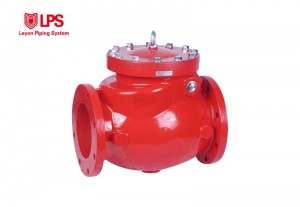A check valve in fire fighting systems is a type of mechanical valve that allows fluid, typically water or fire suppression agents, to flow in only one direction. Its primary function is to prevent backflow, ensuring the water supply remains uncontaminated and maintaining the readiness and pressure of the fire suppression system. Check valves operate automatically, without requiring external control, making them ideal for emergency applications.
Proper placement of a fire fighting check valve is essential for system efficiency and compliance with safety standards. This article provides an in-depth exploration of where and how to position these vital components, covering key considerations, typical installations, and their impact on fire suppression systems.
Key characteristics of a fire fighting check valve include:
· One-way flow: Ensures water moves toward the fire suppression point without returning to the supply line.
· Automatic operation: Requires no manual intervention, making it ideal for emergency scenarios.
· Durability: Built to withstand high pressures and extreme conditions.
The Importance of Placement
Proper placement of fire fighting check valves is critical for maintaining system efficiency and compliance with fire codes. The location of these valves influences the performance of fire suppression systems by:
1.Preventing backflow: Protecting the water supply from contamination or loss of pressure.
2.Maintaining pressure: Ensuring consistent water delivery to sprinklers, hydrants, or other outlets.
3.Reducing damage risk: Preventing water hammer effects and potential pipe damage.
Strategically positioning fire fighting check valves enhances their functionality and extends the lifespan of the entire fire suppression system.
Typical Locations for Fire Fighting Check Valves
Fire fighting check valves are integrated into several types of fire suppression systems. Below are the common placements for these valves, along with their specific purposes.
1.Sprinkler Systems
1)Location: Between the water supply main and the sprinkler network.
2)Purpose: Prevents water from flowing back into the supply line, ensuring the sprinkler system remains charged and ready to activate during a fire.
3)Example: In a wet-pipe sprinkler system, the check valve is typically installed downstream of the system riser.
2.Fire Pumps
1)Location: On the discharge side of the fire pump.
2)Purpose: Prevents backflow into the pump, protecting it from damage due to reverse water flow when the pump is not in operation.
3)Example: For a centrifugal fire pump, the check valve ensures water is delivered directly to the system without recirculating.
3.Standpipe Systems
1)Location: At the base of vertical risers in multi-story buildings.
2)Purpose: Prevents water from flowing back down the riser, maintaining pressure at the upper levels.
3)Example: In high-rise buildings, the check valve helps ensure that water pressure remains consistent across all floors.
4.Hydrant Systems
1)Location: At the connection between the hydrant and the main water supply.
2)Purpose: Prevents contamination of the municipal water supply and ensures the hydrant remains pressurized.
3)Example: Outdoor hydrants often feature a built-in check valve for added protection.
5.Deluge Systems
1)Location: Upstream of the deluge valve.
2)Purpose: Prevents water from draining out of the system, ensuring rapid response when the deluge valve is activated.
3)Example: In industrial settings, check valves help maintain the readiness of foam-water deluge systems.
Common Challenges in Check Valve Placement
1.Water Hammer Effect
Incorrect placement can lead to water hammer, a phenomenon caused by sudden changes in water flow, which can damage pipes and valves.
2.Pressure Loss
Poorly positioned check valves may contribute to unnecessary pressure loss, reducing the effectiveness of the fire suppression system.
3.System Compatibility
Ensuring the check valve is compatible with other system components is essential to avoid operational issues.
4.Maintenance Accessibility
Valves installed in hard-to-reach areas can complicate routine maintenance, increasing downtime and costs.
Best Practices for Placement
1.Consult a Fire Protection Engineer
Engaging a qualified professional ensures the system is designed and installed according to best practices and regulatory requirements.
2.Perform Hydraulic Calculations
Calculating water flow and pressure helps determine the optimal location for check valves.
3.Follow Manufacturer Guidelines
Manufacturers provide specific recommendations for the installation and placement of their valves.
4.Conduct Regular Inspections
Routine inspections verify that valves are functioning properly and identify any need for repositioning or replacement.
Conclusion
Selecting and designing an ideal check valve requires detailed knowledge and striking balances between various performance requirements, environmental factors, and potential trade-offs. We understand that this can be a complex process.Please contact our Leyon team to provide you with the best solution
Moreover, if you have specific concerns or need tailored advice, do not hesitate to contact one of our Technical Sales Engineers. They are skilled and ready to provide the required guidance for your unique situation and assure that you make the most out of your check valve design and selection process. Remember, each check valve directly influences your system’s performance, making its careful selection a matter of great importance.
Post time: Dec-25-2024


